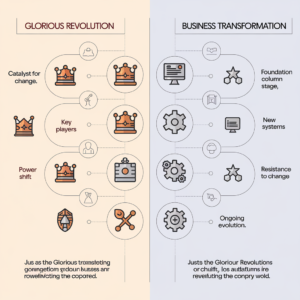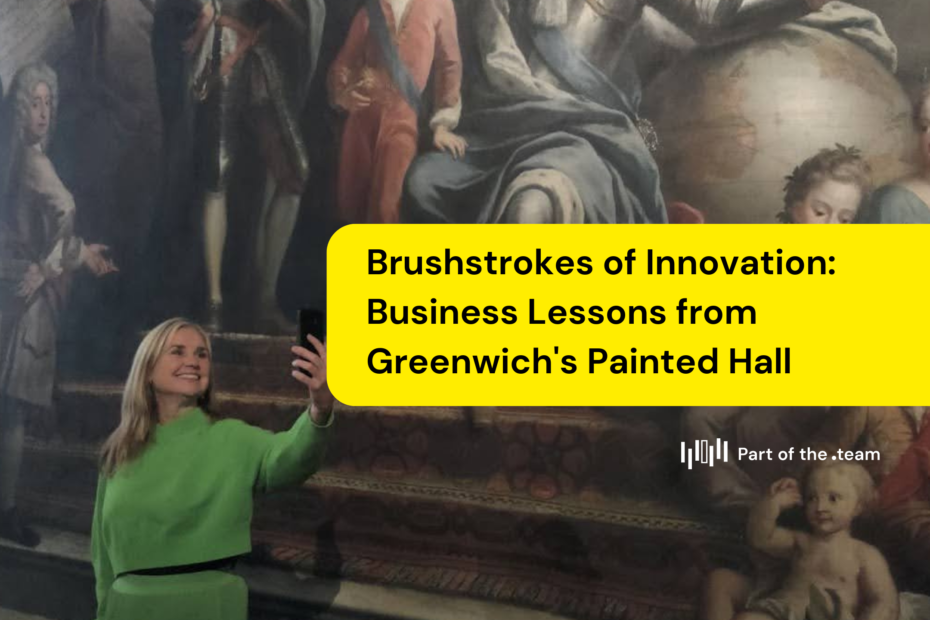As I stepped into the magnificent Painted Hall at Greenwich Naval College for the GreenwichConnect networking event, I felt a wave of inspiration wash over me. Having most of my conversations over video traversing time zones, I was eager for perspectives on business and scaling up in the same longitude as me. Little did I know that this Baroque masterpiece, commissioned to commemorate the Glorious Revolution of 1688-1689, would soon reveal itself as an unexpected source of insight and innovation for modern business practices.

The Painted Hall: A Tapestry of Time, Meaning, and Revolution
The Painted Hall, often called “Britain’s Sistine Chapel,” is more than just a feast for the eyes. Completed in 1726 by Sir James Thornhill, it’s a complex tapestry of allegory and history that holds surprising relevance for modern business practices. At its core, the hall serves as a grand piece of propaganda, celebrating the Glorious Revolution and the subsequent reign of William III and Mary II.
The Bloodless Revolution, a pivotal moment in British history, saw the overthrow of King James II and the establishment of a constitutional monarchy. This bloodless coup d’état ushered in a new era of parliamentary supremacy and laid the groundwork for modern democracy. The parallels between this revolutionary change in governance and the transformative potential of business automation are striking.
The hall’s recent restoration, which won the prestigious 2019 RIBA London Award, showcases how historical treasures can be preserved and enhanced using cutting-edge techniques. This delicate balance between tradition and innovation mirrors the challenges many businesses face when adapting to new technologies and practices.
Allegorical Representations: A Mirror to Modern Business
The hall’s intricate allegorical tableaux offer a rich tapestry of insights when viewed through the lens of contemporary business practices:
Hierarchy and Leadership
The central positioning of monarchs William III, Mary II, and George I in the painting’s composition underscores the pivotal role of visionary leadership in guiding an organization.

In the business world, this translates to the necessity of a clear, top-down strategy for innovation and growth. Leaders must have the foresight to embrace new technologies and methodologies, much like William and Mary embraced a new form of governance.
The Triumph of Virtues
Thornhill’s depiction of virtues vanquishing vices serves as a powerful metaphor for the transformative potential of good business practices. Just as Justice overcomes Calumny in the painting, well-implemented strategies can conquer inefficiencies and streamline operations.
In the context of the Bloodless Revolution, this triumph of virtues represented the victory of Protestant constitutionalism over absolute monarchy. In business, it can symbolize the triumph of efficient, automated processes over outdated, manual ones.
Interconnected Systems
The intricate interplay of figures and symbols throughout the hall mirrors the complex, interconnected nature of modern business processes. This interconnectedness reminds us of the importance of designing seamless workflows that span multiple departments and functions.
Just as the Glorious Revolution led to a more balanced system of governance with checks and balances, modern businesses must strive for people and processes to work in harmony.
The Symbolism of Efficiency
The allegorical figures in the Painted Hall can inspire us to think about key business principles:
- Prudence: This virtue reminds us of the importance of careful planning in business strategy. It’s about making wise, informed decisions that balance short-term needs with long-term goals.
- Justice: In a business context, this can represent fair practices and ethical decision-making. It’s about creating a workplace where everyone has equal opportunities to contribute and succeed.
- Fortitude: This virtue speaks to the resilience needed in the face of business challenges. It’s about having the strength to persevere through difficulties and adapt to changing circumstances.
- Temperance: This represents the need for balance in all aspects of business. While growth and innovation are important, it’s equally crucial to maintain stability and preserve the core values that define your company. The Revolution sought a balance between royal authority and parliamentary power, a lesson in temperance for modern organizations.

The Allegory of Progress: From Revolution to Business Transformation
The Painted Hall’s depiction of Britain’s journey from the Glorious Revolution towards naval supremacy and commercial prosperity offers a powerful metaphor for the stages of business transformation:
- Foundation: This is like the initial sketches of a grand painting or the foundational changes brought about by the Glorious Revolution. It involves establishing the basic structures and processes of your business, much like the Bill of Rights laid the foundation for modern British governance.
- Optimization: This stage is akin to applying paint to the canvas or the refinement of constitutional monarchy in the years following the Glorious Revolution. It involves refining your processes, increasing efficiency, and streamlining operations.
- Innovation: This represents the final touches that bring a painting to life or the long-term effects of the Glorious Revolution on British society and commerce. It’s about introducing new ideas, technologies, or business models that set you apart from the competition, much like how the revolution set Britain on a path to becoming a global superpower.
The Art of Getting Started
Inspired by both the Painted Hall, the Bloodless Revolution, and insights from our recent business innovation webinar, here are some actionable steps for businesses looking to embark on their transformation journey:
- Map Your Customer Journey: Identify key touchpoints and processes that could be improved, much like the revolutionaries of 1688 identified key areas of governance that needed reform.
- Audit Your Current Tools: List your existing resources and assess where improvements can be made. This is similar to how the new government after the Glorious Revolution assessed and reformed existing institutions.
- Start Small: Begin with a “hero platform” or key process and optimize it before expanding. The Glorious Revolution didn’t change everything overnight but started with key reforms that paved the way for broader changes.
- Embrace New Solutions: Explore user-friendly tools and technologies that can enhance your operations. The post-revolution government embraced new ideas and practices, leading to significant advancements.
- Continuous Learning: Stay informed about emerging trends and best practices in your industry. The success of the Glorious Revolution was partly due to learning from past mistakes and adapting to new realities.
Real-World Canvas: Innovation in Action
To bring these concepts to life, let’s look at a real-world example of successful business transformation:
One of our clients, a creative agency, streamlined their employee onboarding process using innovative tools. This reduced their onboarding time from seven manual steps to a smooth, efficient workflow. The result? Faster integration of new team members and reduced administrative burden – a true masterpiece of efficiency.
This transformation mirrors the streamlining of governmental processes that occurred in the wake of the English Civil War, where complex, outdated systems were replaced with more efficient, transparent ones.
The Triumph of Virtues: Your Call to Action
As I left the Painted Hall that afternoon, thanks to the group and the excellent tour guide I felt a renewed sense of purpose. The allegorical representations of virtues triumphing over vices, set against the backdrop of the Glorious Revolution, served as a powerful reminder of how well-implemented strategies can help businesses overcome challenges and achieve new heights.
I was also particularly taken by the fact that Sir James Thornhill, who originally took the project on as a loss leader painted a picture of himself in the corner. The original selfie perhaps?!

Just as the Painted Hall has stood the test of time, inspiring generations with its beauty and symbolism, your business can create a lasting legacy through thoughtful innovation and adaptation.
The journey may seem daunting, but remember – every masterpiece starts with a single brushstroke, and every revolution begins with a single idea.
Are you ready to start painting your business’s future? Take the first step by watching our webinar on “Laying the Foundation: Understanding Automation in Business.” Learn how to blend the wisdom of the past with the innovations of the future, and create a masterpiece that stands the test of time.
